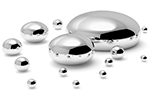
Since ancient times, mercury has been used to treat skin diseases and other illnesses. But its toxicity wasn't fully appreciated until March 1809, when a large cargo of mercury poisoned the crews of two British ships.
Mercury is a liquid metal obtained from cinnabar. People used mercury compounds such as mercuric chloride to disinfect wounds and mercuric sulfide to make bright red vermillion paint. Later it was used in batteries, fluorescent lights, and even felt production, which caused dementia in workers. Thus, Lewis Carroll coined the phrase 'mad hatters' in Alice in Wonderland.
More importantly, mercury was used to extract gold and silver. Mercury surrounds precious metals, and when burned, releases as a vapor, leaving pure gold or silver. That's why those 19th century British ships ended up with the mercury.
The shipment had been intended for South America for the extraction of silver. The metal was in wood containers in the lowest deck of the HMS Triumph, next to the wine and bread rooms. The area was poorly ventilated and hot, and the containers had gotten wet, rotted, and began leaking mercury. The mercury vapor quickly contaminated food and supplies.
Within weeks, the crew showed signs of mercury poisoning. They had partial paralysis, lung and bowel problems, swelling of the head and tongue, and the worst cases lost their teeth and suffered gangrene of the face. Some of the cargo was moved aboard another ship but the setup there prevented a severe poisoning.
Even though the Triumph got a good scrubbing, fresh cases of mercury poisoning appeared. Eventually the ship was broken up in 1850. Despite knowing how toxic the metal could be, many uses of mercury continued through the twentieth century.